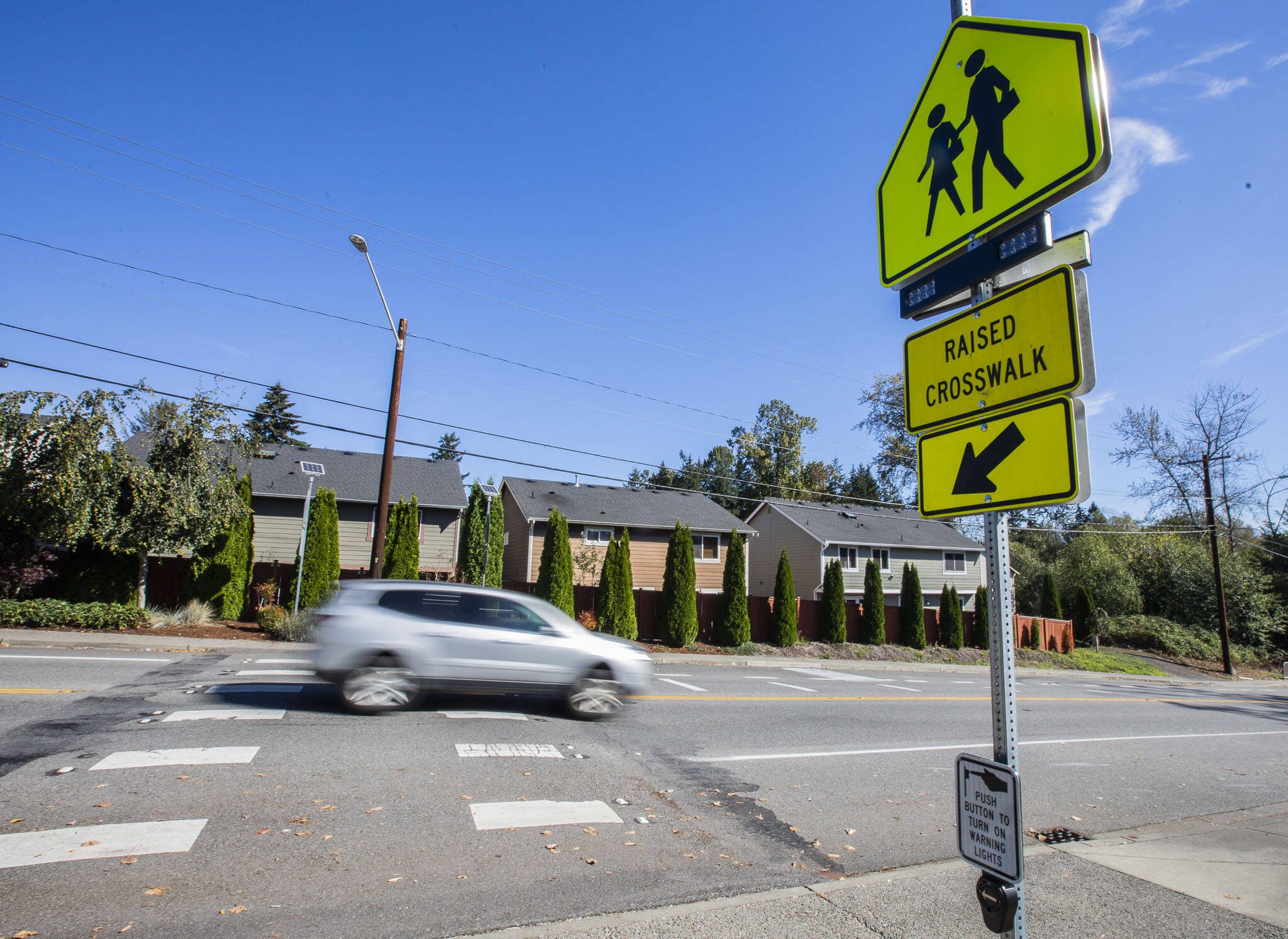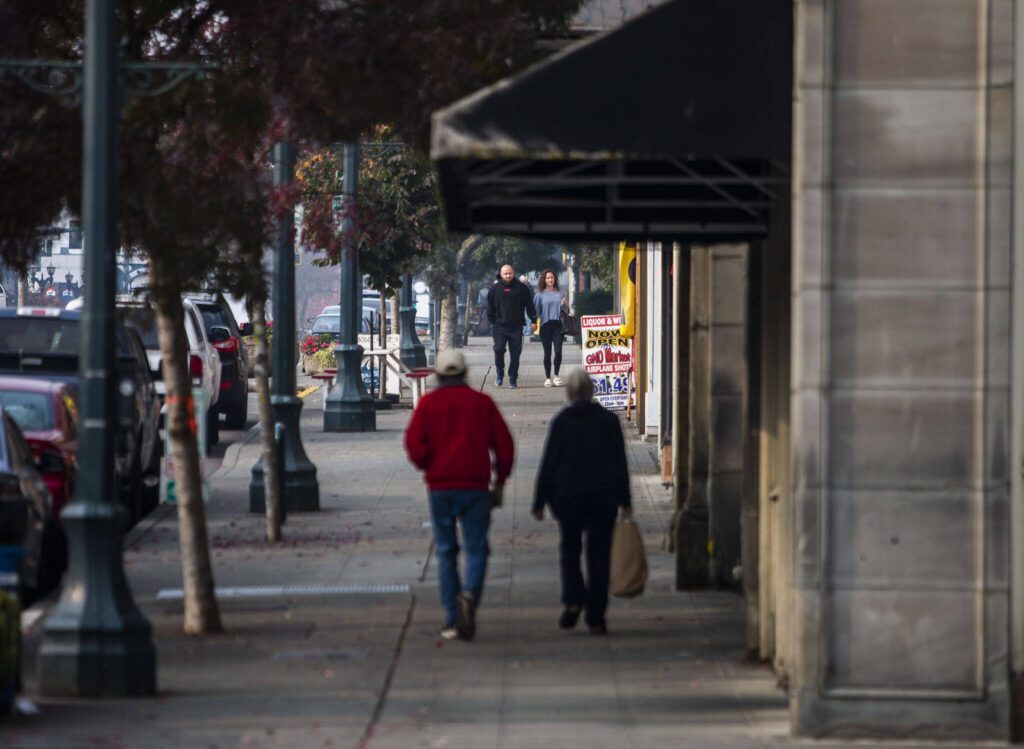EVERETT — Pedestrian deaths are climbing in Everett even as overall crashes decline, pushing city officials to rethink speed limits, crosswalks and road design under the Vision Zero Everett initiative.
Through the initiative, the city hopes to eliminate fatal and serious injury crashes by 2050. It sounds like an “almost unachievable goal,” city traffic engineer Corey Hert said, but it’s the only goal that makes sense.
“Serious injury and death is not acceptable on our roadways,” Hert said. “There’s a responsibility for all of our roadway users to make it safer.”
Vision Zero Everett is adopting the Federal Highway Administration’s “safe systems approach,” which focuses on safer road design, lower speed limits and post-crash care. The initiative is mostly funded by a grant from the Puget Sound Regional Council under the federal Safe Streets for All initiative.
The issue of traffic violence isn’t solely limited to Everett. In 2000, Washington became one of the first states to establish a goal of zero traffic deaths with its “Target Zero” program, but traffic fatalities across the state have failed to decrease since.
In 2023, Washington recorded 810 traffic deaths, the highest number since 1990, according to preliminary data from the state’s Traffic Safety Commission. That marks a 10% increase from 2022, with pedestrian and motorcycle fatalities hitting record highs, according to a 2024 release.
But overall crashes in that time frame have decreased, meaning although crashes are happening less frequently, they are more severe.
“That’s not a scenario that happens very often, where overall crashes decline but serious and fatal crashes increase,” Hert said. “We’ve seen the largest increase in pedestrian-related fatalities, and that’s where we need to focus.”
In Everett alone, 51 people were killed and 286 were seriously injured in vehicle crashes between 2019 and 2023. More than half of those fatalities occurred in just the past two years, according to Vision Zero data. In that time frame, pedestrians made up only 3% of overall crashes but about half of all fatalities.
A total of 34 pedestrians in Everett were killed in crashes between 2019 and March 1, 2025, according to a city study and police records obtained by The Daily Herald.
The rise in traffic fatalities reflects the city’s growing population and changing commuting habits, Everett Police Department spokesperson Natalie Given said. Heavier traffic on major arterials like Broadway and Evergreen, combined with increased driver distraction and reliance on cars using automatic transmission, she said, has led to more dangerous road conditions.
City officials are considering several street safety measures to reduce pedestrian fatalities, which mostly occur while crossing, according to Hert.
These could include curb extensions to shorten crosswalk distances, “no right on red” rules at key intersections to protect pedestrians and a leading pedestrian interval system, which gives pedestrians a head start before cars receive a green light.
States have permitted turning right on red since 1975 as a way to save fuel. But research has shown the practice is generally unsafe for pedestrians, cyclists and drivers while only marginally lowering emissions in certain contexts. Allowing cars to turn right on a red light led to a 54% increase in likelihood to strike a pedestrian and nearly doubled the likelihood of hitting a cyclist, a Department of Transportation study found.
“We just need more and better safe crossings for our pedestrians,” Hert said.
Most of Everett’s fatal crashes happen on a handful of high-speed arterials or within a half block of them, including Evergreen Way, Broadway, Rucker Avenue and Everett Mall Way.
The city is studying speed limits on major roads, some of which haven’t been updated in decades. Two corridors — 16th Street in North Everett and Holly Drive in South Everett — are being considered for reductions.
“Drivers react better at lower speeds and so do pedestrians,” Hert said.
While infrastructure changes are key, officials say driver behavior is also contributing to rising pedestrian deaths.
“There’s been a change in driver behavior,” Hert said. “We’re looking very closely at distracted driving…impaired driving, and speed … seat belt wearing still plays a role in serious injury and fatal crashes.”
The initiative makes it clear that using the road is a shared responsibility, a point Riverside Neighborhood Association chair Rolf Vitous felt was necessary.
“I like the fact the city is being proactive and getting forward. I think it’s going to be beneficial,” Vitous said in an interview Wednesday. “When he was talking about how they are going to focus on everybody being aware and responsible, that aspect is really going to help.”
City staff presented information about Vision Zero at a number of neighborhood meetings, including Riverside’s, since January. As part of the initiative, the city is collecting information from residents about the streets which cause them the most problems.
“If we’re going to create a safer environment in Everett, we’re not going to get the whole story from data,” Hert said.
At the Riverside neighborhood meeting on Tuesday, residents raised concerns over dark streets and unsafe bike paths in their area. In addition to Vision Zero’s plans of engineering changes across the city, some neighbors hoped to see an increase in traffic enforcement and a de-incentivising of car travel in general.
In his neighborhood, most drivers behave normally, Vitous said. But since the COVID-19 pandemic, the outliers have become more extreme — a trend Hert agrees is a problem.
Vitous wants to see increased visibility and more sidewalks in his neighborhood as some solutions the Vision Zero plan could implement. More than anything, though, he wants more people to pay attention when on city streets.
“Everybody using the road, be it bicycle, motorcycle, car or pedestrian, needs to pay attention, be less distracted,” Vitous said. “The safety for everybody out there is pretty much on everybody.”
Public works staff are gathering community input to identify the most dangerous intersections and roadways. Residents can use an online map to mark streets they feel need improvements. The last day to leave comments on the map is March 17.
Correction: This article has been updated to clarify that Everett Public Works staff have been attending neighborhood meetings since January, not March.
Aspen Anderson: 425-339-3192; aspen.anderson@heraldnet.com; X: @aspenwanderson.
Will Geschke: 425-339-3443; william.geschke@heraldnet.com; X: @willgeschke.
To comment: everettwa.gov/3169/Vision-Zero-Everett
Talk to us
> Give us your news tips.
> Send us a letter to the editor.
> More Herald contact information.


























